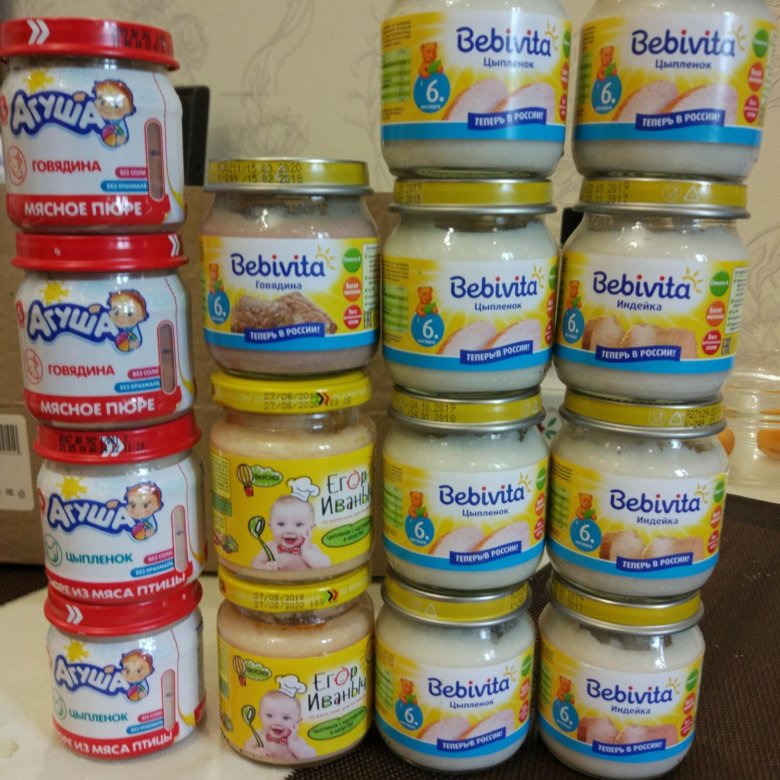When to feed baby rice cereal before bed
Healthy Little Sleepers — To Add Rice Cereal or Not... That is the Question!
Guys… I had a fantastic question this week from a client. One that I get often and one that I thought we can shed some light on.
“Everyone’s telling me to feed my baby rice cereal before bedtime to help my little guy sleep through the night. Should I do this?”
Oh, the rice cereal debate. (There’s always a debate about the “right” thing to do!) If you tried this and it worked for you, then great! But more often than not, there are other things we need to work on to get sleep together and have the best chance at success before considering rice cereal as an add-on. In fact, I have never even recommended adding rice cereal. But to each their own – of course you can!
* * *
HERE’S WHAT THE EXPERTS SAY:
Instead of speculating, I went to the source. The fantastic pediatricians over at Beverly Hills Pediatrics and asked them if adding rice cereal to a baby’s bottle will help with sleeping.
Here’s what they said:
“Do not add rice cereal to increase sleep as it will not change in anyway the baby sleeping from 3 hours to 10 hours, but sleep training will.” - Dr. Scott Cohen, MD, FAAP (author of Eat Sleep Poop)
AND…
“When it's time to eat solids - it should be with a bowl and spoon or finger foods (if stronger kiddo).
And, I generally tell folks to avoid rice cereal when doing solids because it is nutritionally poor and overly processed. I encourage parents to do real foods right from the start. - Dr. Inessa Grinberg, MD, PhD, FAAP
I couldn’t agree more! Straight from the sources.
* * *
WANT MORE EVIDENCE?
I got crafty and looked up research on this topic and found no evidence for adding rice cereal to prolong sleep. The authors studied whether feeding infants rice cereal before bedtime promotes sleeping through the night.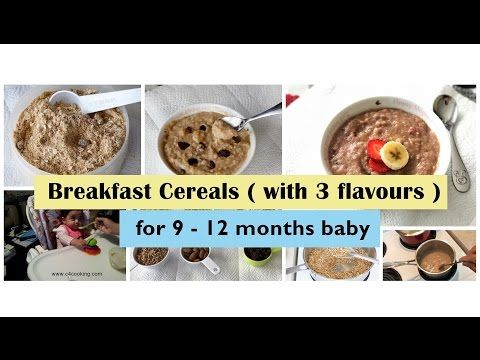
They compared babies sleeping patterns who had rice cereal before bed and those that had none among babies 5 weeks and 4 months of age. Sleeping through the night was defined as sleeping at least 8 consecutive hours, with the majority of time being between the hours of midnight and 6 AM. There was no trend or tendency for one group to have higher sleep than another. Thus, we have our adding rice cereal to the bottle to help with sleep as a myth!
So, at the end of the day if your little one is not sleeping well, and you’ve tried the rice cereal thing, maybe we just need to adjust a few things to get you on a path of setting a healthy sleep foundation.
* * *
one last thing…If you need a little extra guidance in figuring out feedings with your little one and how they coincide with sleep, I’ve got ya! Go here to schedule a FREE 15-minute call with me, and we can chat about it!
* * *
Oh, one more thing!Every other week I share my newsletter — The Healthy Little Note — where you can get this directly in your in box plus other great curated content to help you and your little can get the most out of their first 5 years of life.
If you have little ones, I’m sure you’ll love it!
You can check out the most recent issue here.
Or, SUBSCRIBE below:
———————————————————-
Susie Menkes, PhD is a Certified Pediatric Sleep Consultant through the Family Sleep Institute (FSI) and is dedicated to helping families get their little ones to be healthy little sleepers. She serves on the Medical Board for What’s Up Moms (the #1 Parenting You Tube Channel) and has a sleep talk series at Beverly Hills Pediatrics and Hatch Collection in Brentwood.. As a mom of two, she knows and understands what you are going through and is here to support, educate, and guide you on all matters related to sleep... and more!
Susie Menkesnewborn sleep, baby sleep, baby food, rice cereal, sleep training myths, sleep training
0 LikesWhen is baby rice cereal safe for infants to eat?
Baby cereal is made with oats, barley, rice, or other grains that are ground finely. Fortified baby cereal has added iron and other vitamins and nutrients, making it a good first food for your baby. It has a number of minerals, including iron, zinc, and magnesium; and some varieties have vitamins (such as vitamins A, E, D, and B), too.
Fortified baby cereal has added iron and other vitamins and nutrients, making it a good first food for your baby. It has a number of minerals, including iron, zinc, and magnesium; and some varieties have vitamins (such as vitamins A, E, D, and B), too.
To prepare baby cereal, you can add 1 tablespoon of breast milk, formula, or water to 4 or 5 tablespoons of cereal to give it a soupy consistency; add less fluid as your baby gets the hang of eating more textured food. You can also mix baby cereal with other baby food to introduce your little one to a variety of textures and tastes.
When do babies start eating cereal?
As soon as your baby is ready to eat solid foods, they can try baby cereal. Babies are usually ready to start solids around 6 months. Signs that they're ready include having good head and neck control, being able to sit up on their own, and showing an interest in food (opening their mouth and leaning forward when it's near).
You can also mix baby cereal with other purees, like pear, squash, or prunes, to help them get used to varieties of food. This could be helpful if your baby likes the taste of cereal, but seems reluctant to try other foods. If the puree seems too thick for them, add more liquid to thin it out and make it easier to swallow.
This could be helpful if your baby likes the taste of cereal, but seems reluctant to try other foods. If the puree seems too thick for them, add more liquid to thin it out and make it easier to swallow.
Always feed your baby cereal with a spoon – don't add it to formula or breast milk in a bottle, since your baby could choke on it and they may end up eating more than they need.
Is baby cereal safe?
Baby cereal is safe as long as it's prepared correctly and your baby is ready for solid foods. In fact, baby cereal can be an important part of your baby's diet, since many varieties are fortified with essential nutrients.
Fortified baby cereal is an excellent source of iron, which babies need starting at around 6 months. This is especially important if your baby is breastfed, since breast milk doesn't contain very much iron. (Many formula varieties are fortified with iron.)
Any time you give your baby a new food, wait three to five days before adding another new food to their diet. That goes for different types of grains, too – if you start by giving your baby oat-based cereal, wait before giving your baby another type of grain, like wheat. This way, if your baby has an allergic reaction, it'll be easier to pinpoint what might have caused it.
That goes for different types of grains, too – if you start by giving your baby oat-based cereal, wait before giving your baby another type of grain, like wheat. This way, if your baby has an allergic reaction, it'll be easier to pinpoint what might have caused it.
Signs of a food allergy include hives, itchy skin rashes, swelling, nausea, vomiting, diarrhea, wheezing/trouble breathing and pale skin. If you notice any of these symptoms after your baby eats, let their doctor know.
Advertisement | page continues below
If your baby has symptoms that involve multiple parts of the body (such as hives with vomiting or diarrhea), it could be an anaphylactic reaction. Other signs of an anaphylactic reaction are throat tightness, breathing problems, wheezing, lightheadedness, and loss of consciousness. If your baby shows signs of an anaphylactic reaction, call 911 or go to an emergency room immediately.
Is rice cereal bad for babies?
Rice cereal isn't necessarily bad for babies, but it can contain higher levels of arsenic, which can be dangerous if your baby eats too much. Too much rice cereal can also cause constipation.
Too much rice cereal can also cause constipation.
Arsenic is a common metal that has two forms – organic and inorganic – and many foods and beverages contain both forms in varying levels (including fruit juice). Arsenic is naturally present in water, soil, and air, but processes such as mining, manufacturing, and pesticide use have increased the level of inorganic arsenic in the environment.
Inorganic arsenic is more toxic than organic arsenic and in rare cases can cause certain cancers. (The U.S. Food and Drug Administration estimates that arsenic in rice causes four cases of lung and bladder cancer over a lifetime for every 100,000 people in the U.S.)
Early exposure to arsenic (in the womb, or at a very young age) may also be associated with impaired intellectual development.
Rice is the top dietary source of inorganic arsenic, both because it's a staple in people's diets all around the globe and because rice plants tend to absorb more arsenic than other plants.
Babies typically eat much more rice in relation to their weight than adults do, since rice cereal is often a big part of babies' diets when they first start eating solid foods.
While research shows that most rice cereal brands contain less arsenic than the federally recommended maximum, experts still say it's best to avoid relying on rice cereal as a main source of iron and other nutrients. Instead, give your baby cereal made from different kinds of grains, like oat, barley, whole wheat, and multigrain, since those contain less arsenic. If you do give your baby rice cereal, make sure it's part of a varied diet.
Was this article helpful?
Yes
No
What kind of porridge before going to bed is good for a small child
The content of the article
- 1 Is it possible to feed a child with porridge at night?
- 1.1 Dairy-free porridge
- 1.2 Milk porridge
- 1.3 Ready-made milk porridge
A child's body is more sensitive to external stimuli than an adult's, so it is necessary to feed him. Many foods are forbidden for babies to eat. In addition, attention should be paid to when and what kind of food enters the gastrointestinal tract of children. For breakfast, it is best to give cereals, for lunch, meat. And what to give for dinner? Today we will talk about whether porridge is useful before bedtime, and what kind of porridge to give the child at night.
Many foods are forbidden for babies to eat. In addition, attention should be paid to when and what kind of food enters the gastrointestinal tract of children. For breakfast, it is best to give cereals, for lunch, meat. And what to give for dinner? Today we will talk about whether porridge is useful before bedtime, and what kind of porridge to give the child at night.
Everyone knows that dinner should be light but nutritious. The "lightness" of food depends on the individual characteristics of the baby and the daily routine. A full meal is recommended to organize up to 20 hours. This tactic does not work with children under 2 years old. At this age, a late meal is acceptable.
Many mothers prefer to feed cereals in the evening. This is a healthy product that contains a large amount of nutrients. For children under 2 years old, a thinner porridge is usually prepared as a late dinner, or they are given a purchased one. Thanks to such food, the baby sleeps all night without waking up from hunger.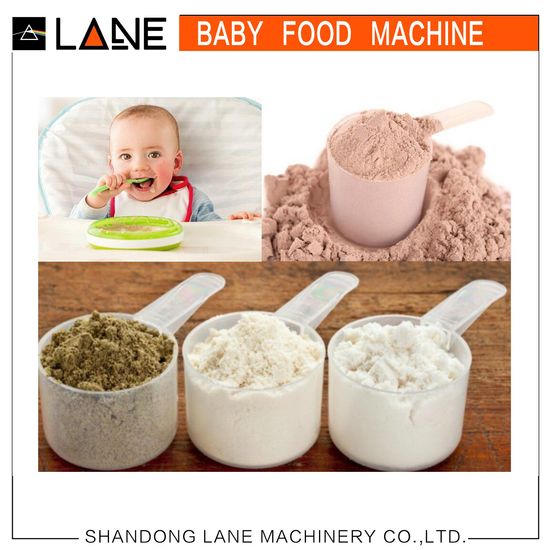 It is recommended to give the baby dinner an hour before bedtime. So he will be full all night, but the food will have time to digest a little, which will reduce the load on the gastrointestinal tract. However, the real thick porridge should not be given so late. Because of such food, the baby’s body does not rest at night, but digests food.
It is recommended to give the baby dinner an hour before bedtime. So he will be full all night, but the food will have time to digest a little, which will reduce the load on the gastrointestinal tract. However, the real thick porridge should not be given so late. Because of such food, the baby’s body does not rest at night, but digests food.
It is important to remember that food is not given by force. According to Dr. Komarovsky, if the child is not hungry, there is no need to force him to eat everything to the end. Firstly, overeating creates unnecessary stress on the stomach, and secondly, it forms the wrong eating habits, which in adulthood can lead to eating disorders.
Dairy-free porridge
It is recommended to have oatmeal, buckwheat or rice porridge for dinner. Do not add sweeteners to dairy-free porridge, but rather replace them with fruits and nuts. Dairy-free meals are considered the most useful, especially for children under one year old. For babies, the cereal is ground with a blender, after which it is boiled until tender.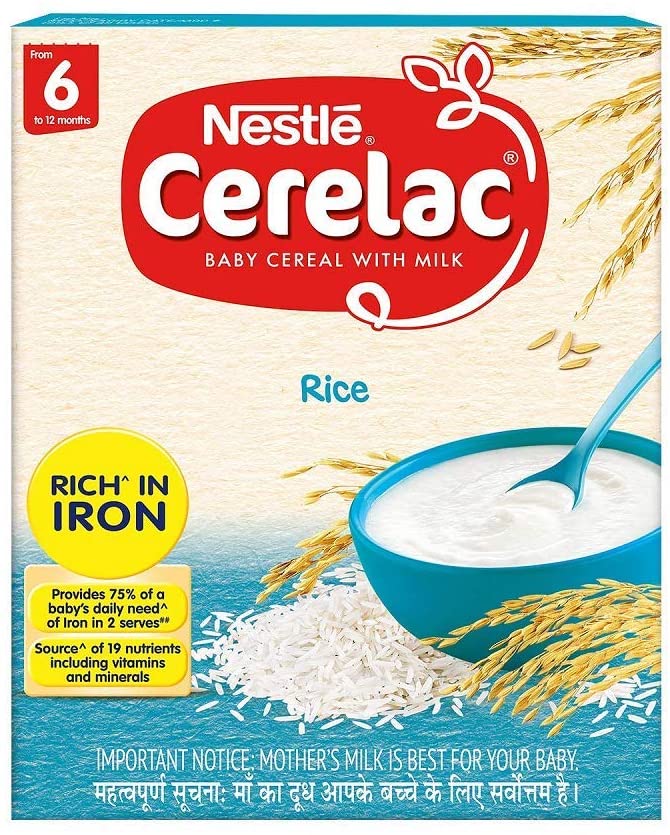 For older children, food is prepared according to the usual recipe.
For older children, food is prepared according to the usual recipe.
It is recommended to choose oatmeal, rice or buckwheat for dinner. Semolina, millet and similar cereals are more difficult to digest, which can cause pain in the tummy. Nutrition experts do not recommend adding sweeteners to a dairy-free dish, it is better to replace them with fruits, nuts, etc.
Milk porridge
As a rule, children prefer dinners with milk. Pediatricians do not recommend adding sweeteners to them, but if the child does not want to eat a savory dish, you can sweeten it a little. Babies prepare a liquid porridge on the mixture. For cooking, cereals must be crushed and boiled. When the dish is ready, the prepared mixture is added to it so that it becomes liquid enough for the child to drink. Children under one year of age should not cook porridge with cow or goat milk, as such products are too heavy for the fragile gastrointestinal tract to digest. For older children, food is prepared with ordinary milk, diluting it with water as desired. Or boiled milk is added to the already cooked porridge on the water.
Or boiled milk is added to the already cooked porridge on the water.
Remember that children often suffer from lactase deficiency or milk protein allergy, so if you notice signs of illness, you should not give the baby such a dish. You can replace regular milk with vegetable milk.
Ready-made milk porridge
Ready-made milk dishes make life much easier for mothers. For their preparation, the dry mixture must be filled with water. A special category should include products called "backfills" or "helpers". The purpose of their use is rapid saturation with a small load on the gastrointestinal tract. As a rule, in a diluted form, they are quite liquid, so children can drink them with a bottle.
The purpose of using ready-made cereals is to quickly saturate with a small load on the gastrointestinal tract. Dr. Komarovsky has nothing against such a product. Good sleep for children is one of the most important components of health. If at the same time it is possible to minimize the load for the mother, this is only a plus. He believes that buckwheat, oatmeal, barley, millet should be chosen. A cooked homemade dish is more healthy in composition, but you don’t need to reproach yourself if you don’t have time to stand at the stove 5 times a day.
He believes that buckwheat, oatmeal, barley, millet should be chosen. A cooked homemade dish is more healthy in composition, but you don’t need to reproach yourself if you don’t have time to stand at the stove 5 times a day.
It is important to remember that such ready-made mixtures contain a large amount of sugar, which can negatively affect the baby's body, so you should not give them several times a day. It is best to feed your baby with such food just before going to bed.
Many manufacturers make such mixtures:
- Nestlé produces Happy Dreams Porridge. It consists of 5 types of cereals and linden blossom. It has a pleasant aroma and taste, so children eat it with pleasure.
- Heep's Good Night Powder is found in every pharmacy. Kids love to eat it. The composition of the product is good, it is safe to feed them to babies. There are several options for such a porridge: rice, oatmeal, etc.
- Semper produces semolina with honey in milk. Nutritionists recommend introducing it into the diet with extreme caution, since the use of honey up to 3 years should be limited, and semolina itself is among the few useful substances in comparison with other cereals.
 Children are advised to give it as a dessert on rare occasions, and choose something else for dinner. Semolina has a heavy composition, which is why the baby can sleep restlessly.
Children are advised to give it as a dessert on rare occasions, and choose something else for dinner. Semolina has a heavy composition, which is why the baby can sleep restlessly. - Cereal porridge with chamomile from Baby is a tasty and healthy product. It contains 3 cereals, so it is not recommended to enter it into the menu for up to a year. Moms need to take note that such a dish contains a lot of gluten, so it is recommended to be careful with it.
- On the shelves of stores you have probably seen ready-made cereals from Fruto Nanny. They contain a lot of sugar, but it will not harm the baby if given in limited quantities.
- Ready mixes "Malyutka" are familiar to us since childhood. Naturally, the constituent components have changed since then. It includes as many as 7 cereals, so pediatricians recommend feeding it at night closer to 2 years.
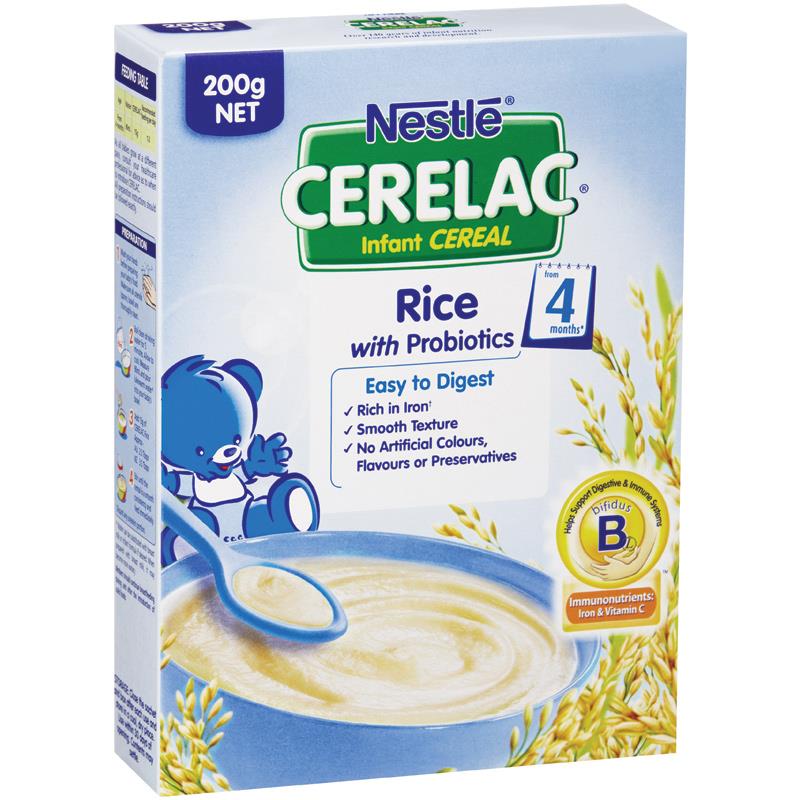
Thus, we see that children can eat porridge in the evening, and often even need to. This will improve sleep by preventing. You can cook semi-liquid masses from cereals yourself, or buy ready-made ones. Remember, ready-made formulas often contain a lot of sugar and other additives that are best not given to the baby, so you need to carefully read the composition of the product.
Porridge for children: is it possible to give porridge to children and from what age? Recipes with water and milk
Everyone knows about the benefits of cereals for a growing organism. It is cereals for children that are one of the first complementary foods and food during illnesses and during periods of rehabilitation. They are nutritious, contain a large number of essential microelements, are well absorbed, and promote digestion.
However, the usefulness factor of the dish depends on the cooking method . For example, buckwheat porridge is a storehouse of iron. Children who consume it frequently are less likely to become anemic. But if you cook buckwheat porridge in milk (as many do), then the benefits of this cereal are minimized. The thing is that calcium from milk prevents the absorption of iron from buckwheat.
Children who consume it frequently are less likely to become anemic. But if you cook buckwheat porridge in milk (as many do), then the benefits of this cereal are minimized. The thing is that calcium from milk prevents the absorption of iron from buckwheat.
Not everything is so simple with semolina. Modern nutritionists have proven its uselessness for healthy children. In addition to the usual carbohydrates that give a feeling of satiety, there is nothing useful for the child in it. However, it is still quite popular.
So, let's figure out which cereals are the most useful for children, how to cook porridge from them and when to introduce the dish into the diet.
Contents:
- Is it possible to give porridge to children and from what age?
- Benefits of porridge for children
- What kind of porridge should I give my child? Which are the most useful?
- Milk or water?
- How to cook porridge for a child: recipes and instructions
- A few tips for cooking porridge
- Cooking examples
- How much porridge to give a child and when?
- The child does not eat porridge - what to do?
Is it possible to give porridge to children and from what age?
WHO recommends that the first complementary foods be introduced at 4–6 months of age. During this period, the baby's activity increases, he gains weight, and breast milk or formula may no longer be enough. The enzyme system of the gastrointestinal tract is ready to start taking adult food. Delayed introduction of complementary foods can lead to beriberi and developmental delay.
During this period, the baby's activity increases, he gains weight, and breast milk or formula may no longer be enough. The enzyme system of the gastrointestinal tract is ready to start taking adult food. Delayed introduction of complementary foods can lead to beriberi and developmental delay.
The scheme for introducing cereals into the diet of a child under one year old is as follows:
6-7 months
The first cereals should be introduced 3-4 weeks after getting used to vegetables. But if the child does not eat up, is not gaining weight well, there are problems with the gastrointestinal tract or a tendency to “liquid” stools, then the pediatrician may prescribe porridge as the first complementary food.
The first cereals should be dairy-free, gluten-free (rice, buckwheat, corn) and monocomponent. Also, the first cereals are cooked without the use of salt, sugar, honey, dried fruits, etc. It is not recommended to cook cereals for children under the first year of life on whole cow's milk.
7-8 months
You can add oatmeal to your diet. Already familiar cereals to try to combine. But only if the child's body is used to them. Porridges can be diluted with additives, such as applesauce.
9-10 months
Introduce barley and wheat groats.
12 months
From this age, you can start cooking porridge with whole cow's milk. But provided that the child is not allergic to it . You can also start giving semolina.
The benefits of porridge for children
Cereal products contain a large amount of carbohydrates, vitamins (group B, iron, zinc, copper, PP, etc.), minerals and vegetable proteins. Cereals are a great source of energy that kids of all ages need so much, especially schoolchildren.
Cereals improve the functioning of the gastrointestinal tract and can help with disorders. So, buckwheat and oatmeal help with constipation, and rice - with diarrhea. The fiber found in cereals helps to remove unnecessary substances from the body, normalizes metabolic processes in the body.
What kind of porridge should I give my child? Which are the most useful?
Prostock-studio/Shutterstock.com
According to the results of numerous studies, the TOP-7 healthy cereals for children were determined: and stimulates the digestive tract. But remember that by cooking cereals in milk, we deprive it of its beneficial properties.
Oatmeal
The benefits of oats are legendary. Even in the old days, seriously ill patients were raised to their feet with decoctions from this amazing cereal and drank the water in which it was boiled to prevent many diseases.
Oatmeal is rich in vitamins B, C, E, fiber. However, it should be understood that instant cereals on the principle of “filled and ready” are of little use. After the processing that they have undergone, and in the presence of flavorings, such cereals are harmful to children. Healthy oatmeal is a porridge cooked from whole grains or flakes, the cooking time of which starts from 3 minutes.
Barley porridge
Prostock-studio/Shutterstock.com
Barley porridge. Barley contains iron, phosphorus, potassium, magnesium, vitamins of groups B, PP, D, A, E, zinc, boron, silicon, fluorine. This cereal is very useful for brain activity and restoring metabolism. But its disadvantage is the duration of preparation. Do not be tempted by store offers and buy instant porridge. It will be of little use.
Millet porridge
This cereal contains iodine, iron, chromium, magnesium and other useful substances. Millet is recommended for children with anemia. It improves the functioning of the gastrointestinal tract, helps to accelerate the process of hematopoiesis, helps to remove antibiotics from the body.
Corn porridge (maize)
Prostock-studio/Shutterstock.com
Due to its vitamin and mineral composition, it is indicated for children with bad teeth. Strengthens bone tissue and immunity, normalizes the functioning of the cardiovascular system. Also, corn stimulates a decrease in the level of fermentation and decay of food residues in the intestines.
Also, corn stimulates a decrease in the level of fermentation and decay of food residues in the intestines.
Rice porridge
The benefits of the dish will depend on the type of grain and how it is processed. The most useful type of rice is brown, not polished. Rice is rich in potassium and phosphorus. With 7 amino acids, rice is an excellent source of energy. Rice porridge improves the functioning of the gastrointestinal tract, removes toxins from the body, and helps strengthen the cardiovascular system.
Flaxseed porridge
Originally a Russian dish, this amazing porridge is a source of omega-3 and omega-6. Flaxseeds contain three times more of these fatty acids than fish. It is also distinguished by a high protein content - 34 g of protein per 100 g of porridge.
Milk or water?
Prostock-studio/Shutterstock.com
For children older than a year, it will be more useful to cook porridge with milk, as the fats in it contribute to a better absorption of vitamins from porridge.
Milk porridge is more nutritious and high in calories, it is an additional source of calcium, which is very important for the development of the child's skeleton and teeth.
But when adding milk, you need to take into account several nuances:
- cereals rich in iron will lose their superpower in the prevention and treatment of anemia;
- when preparing cereals for children under one year old, it is not recommended to use whole cow's milk;
- when preparing milk porridge, you need to be sure that the child's body absorbs this product, he is not allergic to lactose;
- milk is added after or at the end of cooking, otherwise it becomes useless.
If you are allergic to lactose, milk can be replaced with a lactose-free formula, milk from plant ingredients (oatmeal, almond, rice, for example).
How to cook porridge for a child: recipes and instructions
Prostock-studio/Shutterstock.com
Cereals must be free of husks and other debris. You need to cook well-washed cereals, since in warehouses it is often processed from rodents.
You need to cook well-washed cereals, since in warehouses it is often processed from rodents.
It is advisable to use a pan with a thick bottom for cooking porridge. This will prevent it from burning.
If porridge is prepared for babies, then the cereal can be pre-grinded with a blender or coffee grinder. So the porridge will boil faster and will have a uniform consistency.
A few tips for cooking porridge
Prostock-studio/Shutterstock.com
Viscous porridge
To cook a viscous porridge, it must be prepared from crushed cereals and added to boiling water. To prepare a viscous porridge, you need to take 1.5–2 times more water than cereals.
Loose porridge
To obtain loose porridge from buckwheat, pearl barley or millet, cereals and water are taken in a ratio of ½, respectively. Groats are added to boiling water and boiled until water is absorbed. You don't need to stir the porridge.
How to speed up the process?
To make the porridge cook faster, it is pre-soaked. Buckwheat is soaked in cold water 3-4 hours before cooking. It will be possible to have time to cook porridge for children from millet or oats for breakfast if you soak the cereal in hot water overnight. In the morning, swollen porridge will cook very quickly.
Buckwheat is soaked in cold water 3-4 hours before cooking. It will be possible to have time to cook porridge for children from millet or oats for breakfast if you soak the cereal in hot water overnight. In the morning, swollen porridge will cook very quickly.
Cooking examples
Prostock-studio/Shutterstock.com
The food examples below are common for adults and children.
When preparing porridge for a child under one year old, one should take into account the recommendations of pediatricians and do not add spices and cow's milk. Cow's milk can be substituted for breast milk, goat's milk, vegetable milk, powdered infant formula, water, etc. and ease of preparation. You can use semolina porridge not only in its pure form, but also use it for making desserts and creams.
Ingredients:
- 200 ml milk;
- 1 pinch of salt;
- 1 tsp Sahara;
- 1 st. l. semolina with a slide;
- berries, jam, egg yolk, butter to taste.

Cooking method:
- When the milk boils, add salt and sugar.
- Stirring constantly, add semolina. It is important to pour the cereal in very small portions. Then there will be no lumps.
- Do not stop stirring until the cereal is completely swollen, usually this process lasts no more than 5 minutes.
- Add oil and mix well.
- To create fluffiness, semolina porridge can be beaten with a blender, so it becomes like a cream.
- Ready porridge can be diluted with fillers to taste.
Baby Rice Porridge
Prostock-studio/Shutterstock.com
If you and your child don't like rice porridge, you can make crumbly rice with this recipe.
What you need:
- 1 st. rice
- 1 st. water;
- oil and spices to taste;
Recipe:
- To make the rice fluffy, put it in cold water.
- Under cover and over high heat, rice porridge is brought to a boil.

- After that, the fire is reduced to medium, and the porridge is cooked for another 10 minutes.
- After this time, the fire is set to minimum, and the porridge is cooked for about 5 minutes.
- The saucepan is removed from the heat.
- Pot lid replaces with a cloth towel.
After that, the rice porridge will need to stand for another 10 minutes.
Buckwheat porridge for children
Prostock-studio/Shutterstock.com
Grains can be ground in a coffee grinder and boiled for 15 minutes. Such a porridge will turn out liquid and it will be convenient to use it from a bottle. If it turned out a little thick, it doesn't matter. The porridge can be diluted with breast milk or prepared formula.
For an older child and schoolchildren, you can cook buckwheat with cheese, because everyone loves it. This dish is perfect for both breakfast and dinner.
Ingredients :
- 200 gr. buckwheat;
- 500 ml water;
- 50 g hard cheese;
- 30 g oil;
- 1 pinch of salt.
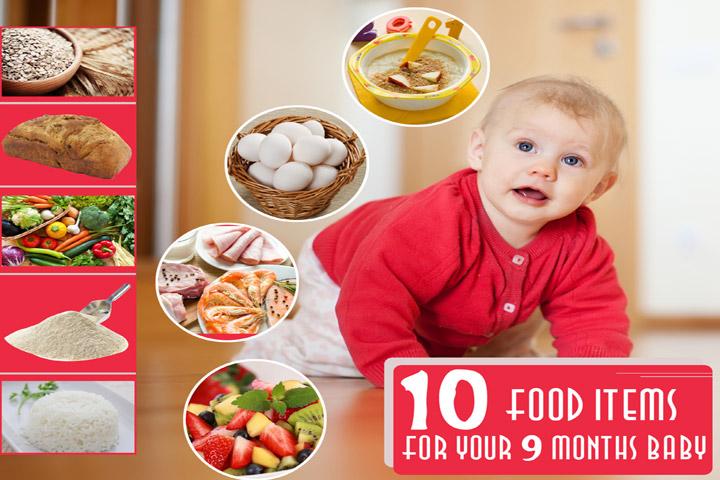
Cooking method:
- Boil buckwheat in salted water until tender. The process usually takes 15-20 minutes.
- While buckwheat is cooking, three large cheese.
- Add butter, cheese to the finished porridge and stir quickly.
The dish is served hot so that the cheese stretches. You can decorate with greenery if the child likes.
Corn porridge
Prostock-studio/Shutterstock.com
Corn porridge is perfect for both babies and older children. It's filling, healthy, and gluten-free. You can cook with both milk and water.
Very tasty when combined with pumpkin.
Ingredients :
- 200 g pumpkin pulp;
- 100 g grits;
- 250 ml milk;
- 25 g oil;
- steamed dried fruits, jam, honey to taste.
Cooking method:
- Pour boiling water over grits and leave to swell.
- While the corn grits swell, cut the pumpkin pulp into small slices and simmer with sugar.
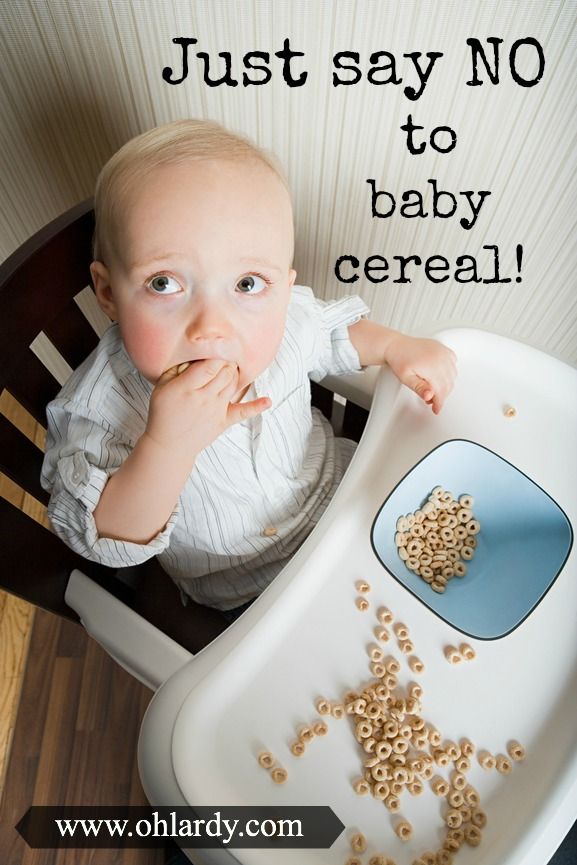
- Pour grits into boiling milk and cook for 15 minutes on minimum heat, stirring constantly.
- A few minutes before cooking, add butter and pumpkin.
- If desired, add honey, steamed dried fruits, etc.
Millet porridge
Prostock-studio/Shutterstock.com
Whole grain millet porridge for children is prepared from 1–1.5 years of age. Until this age, it is recommended to use cereals of varying degrees of grinding or grind yourself.
Since now we have a pumpkin season, and this is a very healthy vegetable that can be introduced into complementary foods for babies from 6 months old, we will consider a recipe for making porridge with it.
Ingredients :
- 130 g pulp;
- 200 ml milk;
- 200 ml. water;
- 0.5 st. cereals;
- oil and spices to taste.
Preparation:
- Cut pumpkin into cubes.
- Place the grits and pumpkin in a saucepan and cover with hot water.

- Boil and remove the film.
- Salt.
- Let the water boil away, it is desirable that the millet remains firm.
- Boil the milk and add it to the porridge.
- Cover with a lid and bring to readiness over low heat.
When serving, add butter and dried fruits to taste.
Milk porridge for children
Prostock-studio/Shutterstock.com
One of the most common breakfast cereals is oatmeal with milk. Delicious, healthy, fast.
It can be diluted with various toppings, frozen berries, made sweet and savory, and even served as a side dish for meat.
For a child over one year old, oatmeal porridge is cooked from unground flakes.
Ingredients :
- 2 tbsp. l. flakes;
- 200 ml milk / water;
- spices, oil, toppings to taste.
Method of preparation:
- Bring the used milk or water to a boil.
- Reduce heat and add cereal.

- Cook the porridge for about 7 minutes, stirring constantly.
- Remove from heat, cover and let steep for 10 minutes.
Water porridge for children
Prostock-studio/Shutterstock.com
Children's cereals can be cooked from several cereals at the same time. This is useful and expands the range of trace elements obtained. However, it should be understood that can only be mixed with cereals that the child has previously consumed.
For example, rice and millet porridge “Druzhba”.
What you need:
- 0.5 tbsp. millet;
- 0.5 st. rice
- 1 liter of water;
- spices to taste.
Method of preparation:
- Mix cereals with water and bring to a boil.
- Reduce the heat to a minimum and cook for another 20-30 minutes, making sure that it does not burn.
- Add oil and spices to the finished porridge.

How much porridge to give a child and when?
Prostock-studio/Shutterstock.com
New products are introduced into the diet of babies from 1-2 tsp. in the morning or afternoon to observe the reaction. With a positive result, the amount of a new product increases proportionally and in a few days the volume is brought to the age norm.
| Product in g or ml. | 4-6 months | 7 months | 8 months | 9-12 months |
| Vegetable puree | 10-150 | 170 | 180 | 200 |
| Milk porridge | 10-150 | 150 | 180 | 200 |
| Fruit puree | 5-60 | 70 | 80 | 90-100 |
| Fruit juice | 5-60 | 70 | 80 | 90-100 |
| Meat puree | 5-30 | 30 | 50 | 60-70 |
| Curd | 10-40 | 40 | 40 | 50 |
Fermented milk drinks (kefir, etc.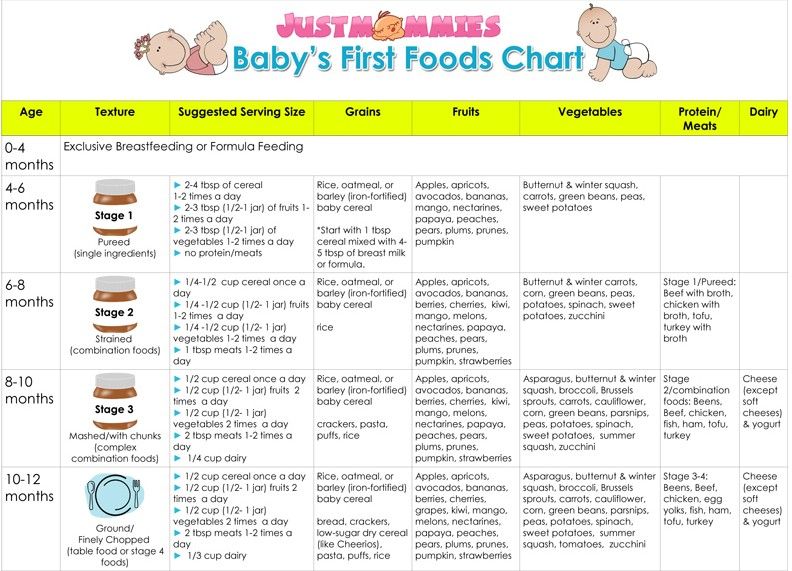 ) ) | - | - | 200 | 200 |
| Fish puree | - | - | 5-30 | 30-60 |
| Yolk | - | 1/4 pcs. | 1/2 pcs. | 1/2 pcs. |
| Biscuits | - | 3-5 | 5 | 10-15 |
| Wheat bread | - | - | 5 | 10 |
| Butter | 1-4 | 4 | 5 | 6 |
| Vegetable oil | 1-3 | 5 | 5 | 6 |
⠀
Porridge is better to give the baby for breakfast. It will provide him with energy and a feeling of satiety for the whole day. However, if the baby sleeps restlessly and often wakes up hungry at night, then evening feeding can be replaced with it.
The child does not eat porridge - what should I do?
Prostock-studio/Shutterstock.com
If the child refuses to eat porridge, the reason should be investigated to correct the situation.
These may include:
- consistency;
- temperature;
- bad experience;
- don't like the taste;
- feeling unwell.
After identifying the cause, you can correct the situation as follows:
- Dilute the porridge with breast milk or formula so that it becomes liquid. With a positive result, gradually reduce the amount of liquid.
- Check that the porridge offered to the child is appropriate for his age group. If the porridge is cooked on its own, then you should try to grind it even more until smooth.
- Change additives. For example, a child refuses to eat porridge with pumpkin. Offer him porridge with an apple.
- Change of scenery. If during the last feeding of the baby something was very disturbing, he was frightened, then it is worth moving the highchair to another room.


